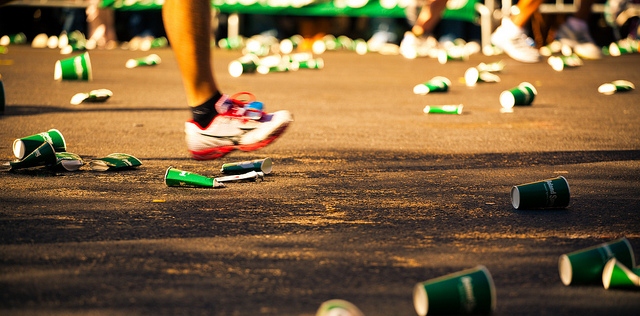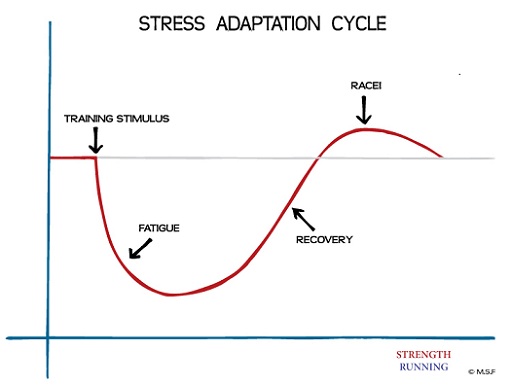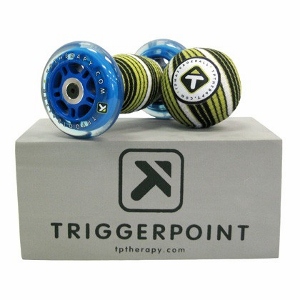Do you do the “little things” that keep you healthy? If you’re the average runner, you don’t – and you’re probably injured.

Preventing overuse injuries is more about what you do when you’re not running. The crucial time right before and after your run are key times to take care of your body. But most runners ignore this time and only run.
They’re missing a HUGE opportunity to stay healthy, run more, and reach more of their goals. Consistency is the key to success in running, so injury prevention and consistent training should be a focus of your training.
I used to skip these two crucial windows…
Five years ago – the “dark days” of my running when I was always hurt – I would come back from work, change into my running gear, and my roommate and I would go for our evening run. Whether it was a workout or easy run, we had the same routine. Work, run, and then eat dinner.
When the run was over, we’d change into dry clothes, get some water, and start cooking. After an hour we were ready to eat and sat in the living room around the coffee table with our other roommates (c’mon, it was a bachelor pad, nobody used the kitchen table!). After too much TV, I went to bed and averaged about 6.5 – 7 hours per night.
And that was it. Do you see the problems with this routine?
If not, let me present eight simple “little things” that you can do before or after your run to keep you healthy.
But first, what’s a running overuse injury?
Overuse Injuries are Trauma
Running injuries are too common among most runners. A few studies have put the annual injury rate as high as 75% – meaning three out of every four runners will get hurt every year and need to take significant time off to heal.
That’s just crazy.
Running injuries are quite simply the result of cumulative trauma to your muscles, tendons, ligaments, or joints. Running puts a lot of stress on your body; don’t let anybody tell you it’s not an impact sport!
Injuries happen when the cumulative trauma you’re inflicting on your legs exceeds the rate at which you can recover from that damage. So prioritizing recovery is crucial to not only get faster (your body “absorbs” the training when you rest), but to prevent injuries.
The stress-adaptation graph below illustrates how your body reacts to training. There’s an initial training stimulus (like a workout), a dip in fitness when you feel fatigued and sore, but after you rest enough your body rebounds and BOOM! You’re in better shape than when you started.

We see here that stress is a good thing. Don’t be afraid of the words “cumulative trauma” because it’s why we train!
Alex Hutchinson recently wrote in a great column in Outside Magazine:
In our obsession with minimizing exercise damage, we may have lost sight of the reason we exercise in the first place: to force our bodies to adapt and get stronger.
Once we know that some exercise damage is a good thing, running becomes the careful management of that damage. Run long and hard enough to force as much adaptation as possible while recovering as much as you need to stay healthy.
Fortunately, there are specific ways to not only help you get faster, but manage the damage (my new slogan!) from running. Say goodbye to running overuse injuries.
Self-massage: learn to love it
Muscle soreness and tightness after a long run or workout are common (and of course, desirable). Sometimes it can be helpful for some self-massage – or a professional massage if you can afford one – to help speed the recovery process.
The fancy term is “myofascial release” and it simply means massage. It can help loosen tight muscles, promote healing blood circulation, and break up scar tissue and soft tissue adhesions. If you have any trigger points in your legs (especially tight and tender to the touch), massage can help release that tight spot.
You can perform self-massage on yourself before you run as part of your warm-up. Just make sure you keep the pressure lighter than usual so you don’t make yourself sore. After you run, you can be a little more aggressive.
Get flexible (but not by stretching)
I don’t support static stretching before or after running – it’s just not effective. Sure, some static stretching after you run doesn’t hurt, but recent studies show that it does nothing for injury prevention. And if you think static stretching before or after your run will prevent muscle soreness – think again.
A better way to promote more functional flexibility is with dynamic stretches. These are simple movements you can do both before and after you run to prepare your body for running, improve your range of motion, warm-up, or increase flexibility.
Not sure where to start? The Standard Warm-up is a dynamic stretching routine that I do almost every day (it takes about 8 minutes).
Fuel up after you run
After a long run or hard workout your body craves nutrients and fuel. There’s a window of about 30 minutes when your body is very receptive to the carbs, protein, and nutrients in your post-workout meal. Make sure you either plan ahead and have something ready to eat or have easily prepared, like energy bars, protein supplements, or a shake.
My favorite post-run fuel is a banana and a protein shake. I’ll eat this immediately after I finish my workout and then have a full meal about an hour later. If you’re pressed for time, make the protein shake in advance and you can take this recovery meal with you.
During marathon or other hard training, it’s crucial to give your body what it needs after those tough long runs and lengthy workouts. I’m a proponent of eating a significant amount of protein as a distance runner – that’s what helps repair muscle damage. You can order protein powder at NutritionFix.com or other online stores.
Get strong in your living room
Many runners think they need a fancy home gym or an expensive monthly membership to get the benefits of strength workouts. That can’t be further from the truth. You can get strong in your living room with a relatively quick workout.
Focus on the basic exercises and you’ll see real results:
- Planks
- Side planks
- Push ups
- Pull ups
- Chin ups
- Bridges
- Squats
Also try out these runner-specific core routines: the ITB Rehab Routine and the Standard Core Routine. Both of these circuits have helped me stay injury-free for the past three years.
Chill out!
Sometimes you just need some quick recovery. That’s where an ice bath or a targeted ice massage (with an ice cup) comes in. Cooling your muscles helps fight inflammation and can speed recovery by reducing how sore you feel. But as we learned earlier, being sore is a good thing so only use ice baths when you’re really sore.
Some of the research on icing is contradictory and doesn’t show a conclusive physiological advantage. Even so, it’s still a common practice among elite runners and I’m a supporter of icing as an effective way to recover from hard workouts through my own personal experiences.
The best way to schedule your ice baths is to use them after an easy run to focus on complete recovery. You can also ice after a particularly hard workout or long run. While you may inhibit some adaptations gained through the workout itself, if you think you ran too much or too hard then it’s worth it.
For the most part, only elite athletes should worry about the tiny percent of fitness they’re losing from an ice bath. Icing has more benefits than drawbacks for “normal” runners like you and me.
Compress your pain away
I was admittedly late to the compression gear party – but now I’m a believer in the technology. Compression socks claim to enhance recovery by increasing blood flow to your feet and lower legs. While you’re running this is a non-starter – your legs are getting as much blood as they possibly can anyways. But at rest, they can help a lot.
Recent research has shown that compression socks increase lactic-acid and heart rate recovery after high-intensity running. Coupled with my personal experience that they work very well (wear them to bed!), then I’m comfortable recommending them to other runners.
The best times to use compression gear is after a tough workout or race when you know you’ll need extra help recovering. They can help boost your lower leg blood flow when normally the blood might pool in your extremities – like during periods of prolonged sitting at work or travel.
The other great time to use compression garments is right before a race. They can help your legs feel better after a day of wearing compression socks so you’re ready to race at your best.
Eat a good diet
Whether you’re a paleo runner, vegetarian marathoner, or a proud “regular diet” omnivore like myself, a good eating plan can be hugely beneficial to your recovery and performance. Put a focus on real food like vegetables, fruit, high-quality meat, fish, nuts, and whole grains (don’t go crazy with whole grains, though).
I have a very simple philosophy when it comes to the perfect runner’s diet and it aligns almost perfectly with Michael Pollan’s famous quote from In Defense of Food: An Eater’s Manifesto: eat food, mostly plants, not too much. Keep it simple and don’t worry so much about your food choices. As long as you’re eating real food you’ll be fine.
Get more sleep
Sleep is a runner’s best friend – prioritize it! Have you ever went to bed hours later than you originally intended because you watched a movie you’ve already seen six times? We’ve all done it and then regretted it the next morning when our alarm goes off.

Your body repairs itself when you sleep. It rebuilds your muscles, builds more mitochondria in response to all the training you’ve been doing, and adapts to your running workload. If you don’t rest then you don’t adapt.
And if you don’t adapt, you don’t become a better runner. Do yourself a favor and get the 8+ hours that your body craves.
Announcing: the Trigger Point Giveaway!
To help you recover from your running, prevent injuries, and be the best runner you can be I’m excited to announce a special giveaway.
We’re giving one lucky SR reader a Trigger Point starter kit – a $70 value. The complete kit includes a massage ball, footballer, and baller block.
They’re designed to be the ultimate self-massage tools; portable, versatile, and perfect for runners who need kinks worked out in the lower legs, feet, quads, or hips. Anybody can learn how to use these tools, making them perfect for beginners.
Check out the video below for more info on the Trigger Point system.
So, you want to win the starter kit? Here’s how to enter:
- Make sure you’re signed up to my private list – only subscribers are eligible.
- Leave a comment below describing the trouble you had with a past or current injury.
- You have until Thursday night at 11:59pm Eastern to leave your comment here.
- I’ll randomly select the winner and email you on Friday.
You don’t have to tweet this post, like it on Facebook, or blog about it for extra entries (though that’d be awesome if you did!). Everyone gets just one entry.
And here’s the awesome part: I’m going to email you a 20% discount code for a specially made bundle of running products. Even if you don’t win, you can save on all of these:
- Anti-burst exercise ball
- Trigger Point massage ball
- Exercise band
- Grid foam roller
- Calf compression sleeves
I hope you’ll enter the contest and then take advantage of the 20% discount. I know you’ll benefit from a Trigger Point Starter Kit!
Remember, only runners on my private list are eligible – I need to be able to email you the discount code and whether you won the contest.
Note: This giveaway is over. Make sure you don’t miss another giveaway by joining the private list here or in the box below.